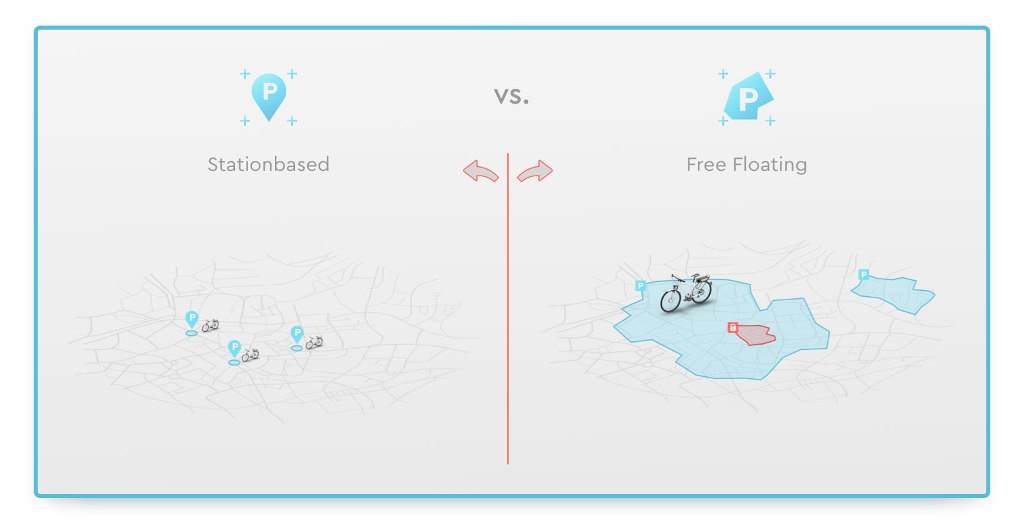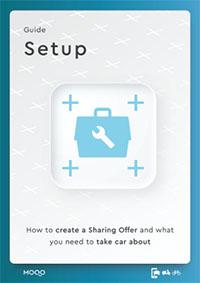Do you see shared mobility as a key driver of the mobility revolution? Do you want to relieve traffic at your location? Complement the public transport system in a meaningful way? Offer your employees or customers an attractive mobility service? For whatever reason you want to offer your shared service: We will show you step by step what you need to consider once you have made your decision. In this way, you will strike a chord with your target group and your market.
The Preparatory Phase
Get to know the market and (potential) users
Before you start designing your offer in detail, take a step back and look at your current local mobility market. This research and analysis phase will provide you with important insights that will later help you develop an offer tailored to your market and target group.
What is the general situation in the market? Are you in a big city with congested traffic and a lack of parking facilities? Or are you in a rural region where the problems are more likely to lie in an inadequate public transport structure? Different circumstances lead to different motivations for (potential) users to use carsharing, bikesharing, etc.
Does shared mobility also work in rural areas? ⟶
Then look at the shared mobility offerings that already exist and compare supply and demand. Are there still gaps and unused potential? Use the rule of thumb that the shared mobility market is currently considered exhausted if there is more than one vehicle per 100-140 inhabitants. However, don't look at the number alone, but also the type of vehicles that are offered for sharing. For example, the carsharing market may be well supplied, but there might be no established bike sharing yet.
Lastly, you should also focus on potential target groups in the analysis. Who are the people interested in shared mobility? What problems does it solve and what needs does it meet? Pay attention not only to demographic and socioeconomic characteristics (e.g., age, gender, occupation, income, marital status...) but rather to psychographic characteristics such as lifestyle, values, and attitudes.
The market analysis explained step by step by example (DE) ⟶

What do you want to achieve - and who do you want to be?
As a rule, the most successful companies are those that pursue a clear vision, that know who they are and what they want to achieve. This insight can also be applied to shared mobility providers. Therefore, consciously take time for your strategic planning and goal setting. In practice, this part of the service design is not necessarily to be considered separately, but rather runs hand in hand with the analysis phase.
Therefore, become aware of why you want to launch a sharing offer on the market. What drives you, what moves you, what problems do you want to solve?
Within strategic planning, you should define goals that you want to achieve with your offering. These can be both financial and idealistic goals. Also, develop your unique selling propositions that differentiate you from competitors. Why is your specific offering needed? This leads on to the target group, which you can now define and narrow down, as well as the geographic market.
Public or private offering?
You can make your sharing offer available to the general public as well as to a limited group. Private offers are aimed at the employees of a company or the residents of a residential area, for example. The sharing offer then often represents an enhancement of the actual primary service.
How eins energie combines public and private sharing offers ⟶
Success has to be learned: Keep an eye on the numbers
No matter how innovative and user-oriented your offering may be, in the end it needs a stable financial framework to last.
To do this, you need a realistic overview of all costs incurred. A large part of these are, of course, the fleet with acquisition or alternatively leasing costs, costs for maintenance, repair and cleaning, equipment, fuel and loading costs as well as depreciation. Other cost centers are internal or external employees, costs for software, IT and telematics units, rent, insurance, taxes, marketing costs, bank charges...
Assume that in addition to the plannable costs, unexpected costs can always come your way. But: You don't have to start right away with a large fleet and several employees. Many providers start with a pilot project with just a few vehicles and then grow step by step. Depending on the initial situation, there are also no additional rental costs, as you may already be able to use existing premises.
In the long term, all your expenses must be covered by your revenues. Therefore, a comprehensive and forward-looking cost calculation helps you to derive realistic usage rates based on this. Calculate the contribution to cost recovery that a single trip must generate and the utilization of your vehicles that you need in order to operate profitably.
However, since very few sharing offers are profitable from day 1, you need an appropriate financing plan for the start and the first months to years. Financing options are, in addition to sufficient equity, loans from the bank, investors or crowdfunding. Also check whether you might be eligible for funding (e.g. funding programs for e-mobility). Funding and financing support take some of the financial pressure off you in the initial phase, so that you have time and space to test your offer and make it known to the target group.
The Design Phase
Develop your business model
There are different business models in the shared mobility industry. This starts with the type of vehicle offered: Do you want to operate classic car sharing, van sharing or rather micro mobility with bicycles or scooters? A combination of different products (= mixed mobility) is also possible.
Another key differentiation point is the decision between a station-based or a free-floating model. Station-based means that you define stations where your vehicles can be picked up. You can operate either a roundtrip sharing or a one-way sharing, i.e. you can determine whether the vehicles can be returned to a station other than the rental station.

Free floating, on the other hand, refers to a business model in which vehicles can be rented and parked at any location within a delimited business area. This model is found in particular in large cities with a high population density. It is important to note that with free floating, no reservations can be made for a time in the future.
If you opt for a station-based business model, the selection of stations is an important success factor. Analyze exactly where there is a high demand for a sharing station. In principle, both the proximity to a residential area and the location at important transport hubs such as train stations or bus stops are recommended.
Legal framework
In some cities or counties, there are certain regulations that you must adhere to as a sharing provider. For example, free floating offers are sometimes not allowed in the entire city area or there are certain guidelines for setting up rental stations.
You should also keep an eye on issues such as liability, necessary insurances and the obligations as a vehicle owner.
The heart of your offer: the fleet
Pay sufficient attention to the composition of your fleet - both in terms of the number and models of vehicles. Once again, your defined target group plays a role here. If you are targeting business people who travel to business appointments by car, the brand and design of the vehicle will play a greater role than for a family man who uses the car to do the weekly shopping.
Electric vs. combustion engine
The question of electric or combustion engine quickly becomes a question of beliefs. But once again, it is much more important to focus on your target group. Are electric vehicles suitable for the purposes for which your sharing offer is to be used? Is your target group open to electric mobility? Is there sufficient charging infrastructure in your area?
It's important to know: a sharing model works with both electronic and conventional vehicles. Decide which better suits your business strategy.
Quickly overlooked but also of importance is the equipment of your vehicles. While bicycles usually don't need anything else besides a locking system, you should equip scooters with a helmet. For cars, the list of equipment is even a bit longer, because in addition to mandatory materials such as a first aid kit, warning triangle and high-visibility vests, you should also leave, for example, an ice scraper and a fuel or charging card.
Note
Most carsharing providers include the cost of fuel or electricity in their rates. However, very few drivers are willing to pay in advance to recharge or refuel the vehicle. To ensure that the car remains roadworthy, it should be equipped with a card that drivers can use to pay at gas stations or charging stations.
In order for a vehicle to be opened and locked via the smartphone, it also requires an installed telematics unit or, in the case of bicycles, a smart lock. Via telematics, the vehicle can communicate with your software system and, for example, display the current fuel or charge level in the app.
The right software
This leads us to the next important step in your service development: the software. On the one hand, you need an app that drivers can use to book, open, close and pay for vehicles. On the other hand, you need a platform with which you can manage users, vehicles, and bookings, set rates, perform billing, and view statistics.

You get further individualization options via possible interfaces to other software services as well as various features. Find a software package that meets your needs and requirements. Since the entire customer journey is handled by the system, you depend on its stability, functionality and security. Only a clean and intuitive booking process leads to high user satisfaction.
Reaching customers with targeted marketing
At the end of the day, your shared mobility offering depends on people using it. And to ensure that, in most cases you will need a marketing strategy and a targeted approach to your customers.
Develop an individual brand personality and stringent branding. All customer touchpoints should reflect your brand design - including website, vehicles, and stations. If you want your brand to be particularly prominent, a white label app is recommended. But even without a white label app, you can incorporate your brand in several places in the MOQO app, such as via your logo or your vehicle images.

In addition, look for suitable channels on which you can reach your target group. High-reach and cost-effective options are social media channels. But local or industry-specific media are generally not averse to reporting on new sharing offers. Therefore, feel free to try to establish good PR contacts. Ultimately, you will also gain attention through classic (online or print) advertisements and can use them, for example, to promote special offers for the launch.
In general, awareness on different channels increases the likelihood of user interaction. Therefore, rely on a mix of different media and measures.
Other marketing tools that should be mentioned are discount codes or friend-referral offers. Through such offers you increase your reach and attract new drivers.

Conclusion
Let's be honest: Setting up your own sharing service is a lot of work and also requires a good dose of passion. But it is a contribution that pays off - not only financially, but also through an improved image, satisfied customers and a valuable contribution to the future of transportation. Allow time for the individual steps of your planning and development phase to create an offer that meets the wishes and needs of your target group. And: Look for strong partners who can support you in the various aspects of your venture and enrich you with valuable know-how.






